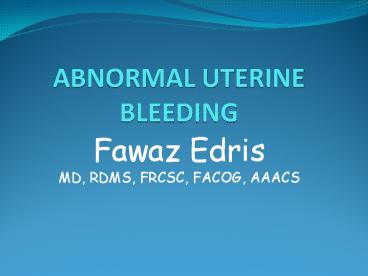ABNORMAL UTERINE BLEEDING - PowerPoint PPT Presentation
1 / 18
Title:
ABNORMAL UTERINE BLEEDING
Description:
Fawaz Edris MD, RDMS, FRCSC, FACOG, AAACS INTRODUCTION 1/3 of outpatient visits Most after menarche or perimenopausal Multiple causes, but mostly: Pregnancy related ... – PowerPoint PPT presentation
Number of Views:193
Avg rating:3.0/5.0
Title: ABNORMAL UTERINE BLEEDING
1
ABNORMAL UTERINE BLEEDING
- Fawaz Edris MD, RDMS, FRCSC, FACOG, AAACS
2
INTRODUCTION
- 1/3 of outpatient visits
- Most after menarche or perimenopausal
- Multiple causes, but mostly
- Pregnancy related (always R/O)
- Structural uterine pathology (fibroids, polyps,
adenomyosis) - Anovulation
- Disorder of hemostasis
- Neoplasia
- Trauma
- Infection
- More than 1 !! (myoma cancer)
- Non gynecological source (urethra, rectum)
3
MENSTRUAL CYCLE
- Mechanism Estrogen ? Ovulation ? Preogesteron ?
withdrawal ? menstruation - 24 - 35 days, lasting 2 to 7 days, flowing lt80
mL/cycle - Predictable cyclic menses reflect regular
ovulation - DUB vs. AUB
- DUB anovulation no anatomical or systemic
disease by exclusion
4
PATTERNS OF AUB
- Menorrhagia excessive (gt80 mL/cycle) or
prolonged menstrual bleeding (gt7 days) - Amenorrhea absence of bleeding 3 usual cycles
- Oligomenorrhea bleeding with interval gt 35 days
- Polymenorrhea bleeding with interval lt 24 days
- Metrorrhagia light bleeding at irregular
intervals - Menometrorrhagia heavy bleeding at irregular
intervals - Intermenstrual bleeding bleeding between menses
- Premenstrual spotting light bleeding preceding
menses - Post coital spotting vaginal bleeding within 24h
of intercourse
5
HISTORY
- What is the nature of the bleeding (frequency,
duration, volume, relationship to activities such
as coitus) - Quantity number of pads, soakness
- Intermenstrual bleeding - structural lesion
(endometrial polyp, fibroid, cervical neoplasia) - Menometrorrhagia - anovulatory bleeding
- Regular cyclic periods ovulatory
- Menorrhagea - bleeding diathesis, fibroid,
adenomyosis.
6
HISTORY
- Are there symptoms of ovulation? (molimina)
- When did the bleeding start?
- Menorrhagia since menarche - Bleeding diathesis
- Perimenarcheal and perimenopausal - Anovulation
- Perimenopausal - polyps, adenomyosis, and
fibroids - Were there precipitating factors, such as trauma?
7
HISTORY
- Any associated symptoms?
- Lower abdominal pain, fever, vaginal discharge -
infection (endometritis, vaginitis) - Changes in bladder or bowel function - mass
effect from a local neoplasm or nonuterine
bleeding - Headaches, breast discharge, visual disturbances
- prolactinoma or other cranial tumor - Hirsutism or hair loss, acne PCOS
- Cold or Hot intolerence, Constipation or diarrhea
- thyroid disease
8
HISTORY
- Is there a personal or family history of a
bleeding disorder? - bleeding associated with surgery, dental
extraction, childbirth, or bruising (gt5
cm)/epistaxis/bleeding gums once or twice a month - Does she have a systemic disorder?
- chronic liver or renal disease, thrombocytopenia
- menorrhagia - Any medications?
- Anticoagulants menorrhagia
- IUCD or OCP - intermenstrual bleeding
9
HISTORY
- Is she having coital relations?
- Pregnancy related
- Always do pregnancy test
- Change in weight, eating disorder, excessive
exercise, illness, or stress? - Anovulatory bleeding
10
PHYSICAL EXAMINATION
- Speculum and pelvic examinations
- Bleeding site vulva, vagina, cervix, urethra, or
anus - Any suspicious findings (mass, laceration,
ulceration, vaginal discharge, foreign body) - Assess the size, contour, and tenderness of the
uterus - fibroids, adenomyosis, pregnancy, or infection
- Examine the adnexa for an ovarian tumor
- Evaluate for pain - infection
11
PHYSICAL EXAMINATION
- General examination
- Signs of systemic illness, such as fever
- Ecchymoses
- Enlarged thyroid gland
- Hyperandrogenism (hirsutism, acne, clitoromegaly,
or male pattern balding) - Acanthosis nigricans - insulin resistance and
anovulation. - Galactorrhea - hyperprolactinemia.
12
LABORATORY EVALUATION
- Pregnancy test in all reproductive age women
- Intrauterine pregnancy
- Ectopic
- Gestational trophoblastic disease
- Cervical cytology
- Any visible cervical lesion should be biopsied
13
LABORATORY EVALUATION
- Endometrial biopsy - endometrial cancer
hyperplasia - All women gt 35 years
- 18 and 35 years if with risk factors for
endometrial cancer (family or personal history of
ovarian, breast, colon, or endometrial cancer
tamoxifen use chronic anovulation obesity
estrogen therapy prior endometrial hyperplasia
diabetes) - Always r/o pregnancy then do in second half of
cycle - Secretory endometrium - ovulation
- Proliferative endometrium anovulation
- Inflammation of the endometrium - endometritis
14
ADDITIONAL LAB. EVALUATION
- Hemoglobin/hematocrit
- TSH
- Coagulation tests
- Platelet count thrombocytopenia
- Coagulation testing - PTT, PT, factor VIII, and
von Willebrand factor antigen and activity - STD Gonorrhea, Chlamydia, trichomonads
- Prolactin level
- Androgen levels Testosterone, DHEAS
15
ADDITIONAL LAB. EVALUATION
- Ultrasound
- Fibroids, adenomyosis, endometrial lining,
ovaries - Saline infusion sonography (sonohysterography)
- Fibroids, polyps
- Hysteroscopy
16
MANAGEMENT
- Is bleeding ovulatory or anovulatory?
- Ovulatory ? treat the underlying cause
- Anovulatory
- Acute management
- Estrogen Oral or IV
- DC (temporary measure not therapeutic)
- Ongoing management
- Replace Progesterone
- Progesterone pills (continuous or cyclical),
injections - OCP
- Other measures
- Thin the endometriam hormonal IUCD
- Remove the endometriam Ablation
- Remove the organ Hysterectomy
17
MANAGEMENT
- If bleeding persists after treatment
- Additional etiologies ? continue to evaluate
18
- Thank you































